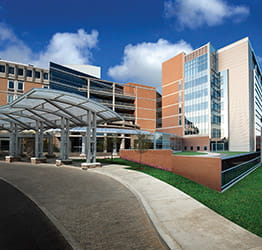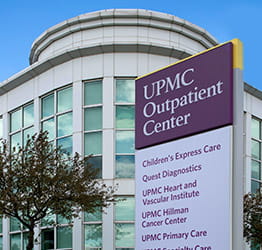What Is Interventional Radiology?
Interventional radiology procedures are used to diagnose and treat a broad range of diseases, providing less invasive options when compared to open surgeries. During an interventional radiology procedure, your doctor will make a small incision and guide specialized instruments — such as tubes or wires — to the treatment area using x-ray, magnetic resonance imaging (MRI), computed tomography (CT), or ultrasound guidance.
What is an interventional radiologist?
Interventional radiologists are board-certified physicians who:
- Have expert training in the procedural, diagnostic, and therapeutic aspects of a range of procedures.
- Provide comprehensive knowledge of the least invasive treatments available, combined with diagnostic and clinical experience across all specialties.
- Specialize in minimally invasive, targeted treatments.
- Utilize x-ray, MRI, ultrasound, CT, and other advanced imaging techniques to navigate a catheter through the body — typically an artery — to address the source of the disease without requiring surgery.
Types of interventional radiology procedures
Interventional radiology procedures are typically performed under imaging guidance using:
Types of interventional radiology procedures include:
- Ablation — Involves inserting small applicators through the skin that use energy to destroy benign and cancerous kidney, liver, lung, soft tissue, and bone tumors. Doctors may combine it with other therapies such as chemotherapy, radiation, and surgery.
- Angiography — Detects blocked or narrowed arteries and veins using an x-ray. Doctors may insert a type of stent that expands to open your blood vessel.
- Angioplasty — Treats blocked vessels, such as those in the legs or kidneys. Balloon angioplasty uses a catheter with a small balloon at the tip that is inflated to open the vessel. After the artery is opened, doctors insert a stent to prop it open.
- Cancer treatment — Uses minimally invasive techniques to deliver cancer drugs directly to the tumor site.
- Embolization — Uses a small tube to insert a substance — such as coils, glue, particles, or beads — into a blood vessel to stop excessive bleeding or treat enlarged prostates and uterine fibroids.
- Endovascular arteriovenous (AV) fistula creation — Uses minimally invasive techniques to create an AV fistula for dialysis access.
- Feeding tubes — Involves inserting a tube into your stomach to provide nourishment if you can't eat or drink by mouth.
- Foreign body extraction — Uses a catheter to retrieve a foreign body, such as a blood clot, from a blood vessel.
- Genicular artery embolization (GAE) — A minimally invasive treatment option for painful knee osteoarthritis. GAE reduces blood flow in abnormal vessels around your knee joint to reduce pain and inflammation.
- Inferior vena cava filter placement/removal — Inserts a small, temporary filtering device into a large vein in your abdomen to prevent blood clots from your legs or pelvis from traveling to your lungs.
- Intravascular ultrasound — Uses ultrasound to allow doctors to see inside a blood vessel and detect problems.
- Needle biopsy — Uses imaging techniques to guide a small needle into an abnormal area almost anywhere in the body to get a tissue sample to extract cells or tissue for a diagnosis.
- Prostate artery embolization (PAE) – A minimally invasive treatment option for an enlarged prostate gland. PAE shrinks the prostate to reduce lower urinary tract symptoms like frequent urination and incomplete bladder emptying.
- Stent placement — Places a tiny tube (stent) inside a blood vessel at the site of a blockage. The stent expands to clear the blockage and open the vessel.
Conditions we treat with interventional radiology
Why Would I Need Interventional Radiology?
You may need interventional radiology care if your doctor suspects that you have a condition that could be diagnosed or treated with a minimally invasive procedure.
Who’s a candidate for interventional radiology?
You may be a candidate for an interventional radiology procedure if your doctor thinks you could benefit from minimally invasive care or if you are not a candidate for traditional surgery.
Compared to open surgery, interventional radiology procedures typically offer benefits including:
- Lower risk of complications or side effects.
- Reduced pain.
- Shorter recovery time.
Alternatives to interventional radiology procedures
In most cases, traditional open surgical procedures are an alternative to interventional radiology care.
What Are the Risks and Complications of Interventional Radiology Procedures?
Like all medical procedures, interventional radiology procedures come with some risks, including:
- Allergic reactions.
- Bleeding.
- Device problems.
- Infection.
- Skin side effects from radiation, although they are very rare.
What Should I Expect from Interventional Radiology Procedures?
Before: How to prepare for interventional radiology procedures
How you prepare for an interventional radiology procedure depends on the specific procedure you are having. Your doctor will provide specific instructions.
To prepare for most types of interventional radiology procedures, you should:
- Fast for a certain amount of time before the procedure. Your doctor will inform you how long to fast (typically overnight).
- Have any tests that your doctor has recommended. For example, your doctor may request a blood test before the procedure to determine how long it takes your blood to clot.
- Tell your doctor if you are sensitive or allergic to any medications, iodine, latex, tape, or anesthetic agents (local and general).
- Tell your doctor about all medications (prescription and over-the-counter) and herbal or other supplements you are taking.
- Tell your doctor if you have any other health conditions. Your care team may need to take certain precautions during your procedure for your safety.
- Tell your doctor if you have a history of bleeding disorders or if you are taking any blood-thinning medications, aspirin, or other medications that affect blood clotting. You may need to stop some of the medications prior to the procedure.
- Tell your doctor if you are breastfeeding, pregnant, or think you might be pregnant.
On the day of your procedure, please bring your photo ID and health insurance card(s). Leave valuables such as cash and jewelry at home.
You may be discharged the same day as your procedure, or you may need to stay in the hospital overnight. Your doctor will let you know what to expect.
If you need to stay overnight, please bring toiletries, a robe, slippers, a cell phone and charger, any necessary medications, and a change of clothes. You will also need to arrange for someone to drive you home after you are discharged.
How long do interventional radiology procedures take?
Depending on the type of procedure you are having, interventional radiology procedures can take anywhere from a few minutes to several hours.
During your interventional radiology procedure
There are many types of interventional radiology procedures, each with different processes and steps. Depending on the procedure, you may have local anesthesia to numb the catheter insertion site or general anesthesia to put you to sleep.
During your procedure, your doctor will:
- Give you an IV for fluids and medication, if needed.
- Make a small incision and insert a catheter into a blood vessel. Your incision may be in your wrist, groin, or another part of your body.
- Use imaging guidance to move the catheter through your blood vessels to the treatment site.
- Perform the procedure to diagnose and/or treat the disorder.
- Remove the catheter and close the incision.
Recovery after interventional radiology procedures
After your procedure is complete, you will be monitored in the recovery area. If you are staying overnight in the hospital, you will be transferred to your room. If you are discharged the same day, you will be released from the hospital when your condition is stable.
Whether you stay overnight or are discharged the same day, you will need to arrange for someone to drive you home from the hospital.
Before you go home, your doctor will tell you:
- How to care for your incision and watch for signs of infection or complications.
- What medications to take.
- When to call your doctor or 911 if you have certain symptoms.
- When to schedule your follow-up appointment, if one has not been scheduled.
- When you can return to your normal activities, such as driving and bathing.
Your incision will heal in about a week. However, you can resume your regular diet and take your medications as directed immediately after your procedure.
When to call your doctor about complications
You should let your doctor know if you have:
- A fever of more than 100.4°F.
- Difficulty breathing.
- Pain, redness, bleeding, drainage, or increased swelling at your treatment site.
- Severe pain that does not respond to medication.
What’s the success rate of interventional radiology procedures?
Interventional radiology procedures are minimally invasive alternatives with outcomes comparable to or exceeding those associated with traditional open surgeries.
For people who may not be eligible for surgical procedures due to other health conditions, interventional radiology procedures can provide effective treatment with a reduced risk of complications and a shorter recovery. Your doctor will discuss your treatment options and expected interventional radiology success rate with you.
Why Choose UPMC for Interventional Radiology?
When you choose UPMC for interventional radiology, you will receive:
By UPMC Editorial Staff. Last reviewed on 2025-08-28.
















